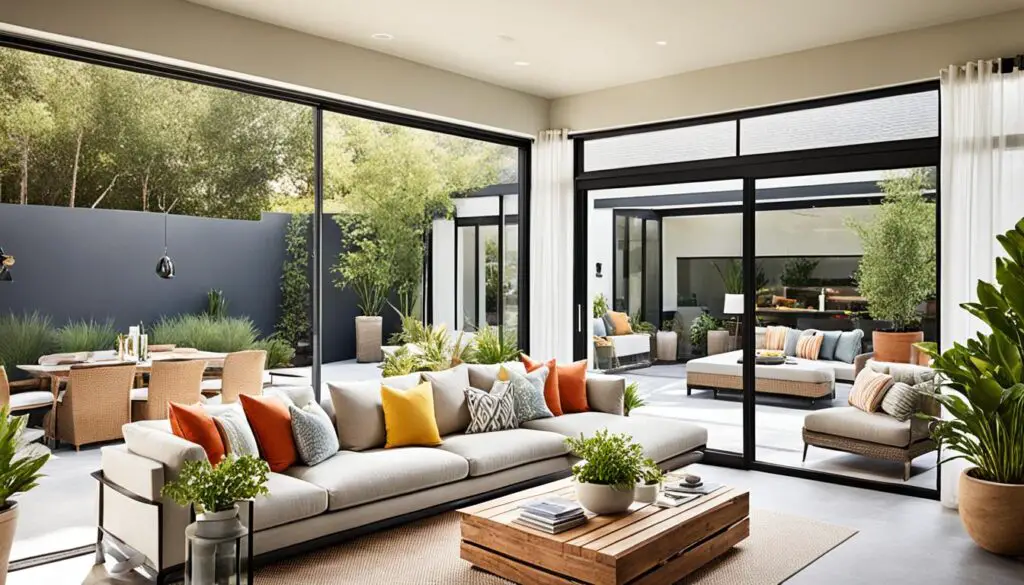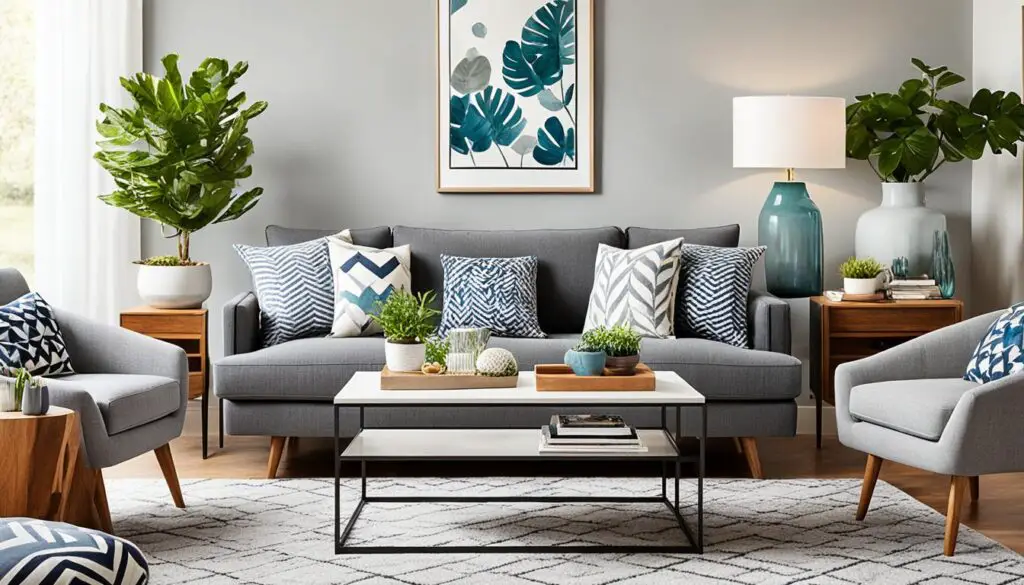
Explore the perfect mix of Scandinavian minimalism and Japanese wabi-sabi in our 20 Japandi living room ideas. These spaces bring together clean lines, warm textures, and a feel of nature. They show how to make your living area a peaceful retreat with Japandi’s focus on natural beauty and mindful living.
Embrace the Essence of Japandi Style
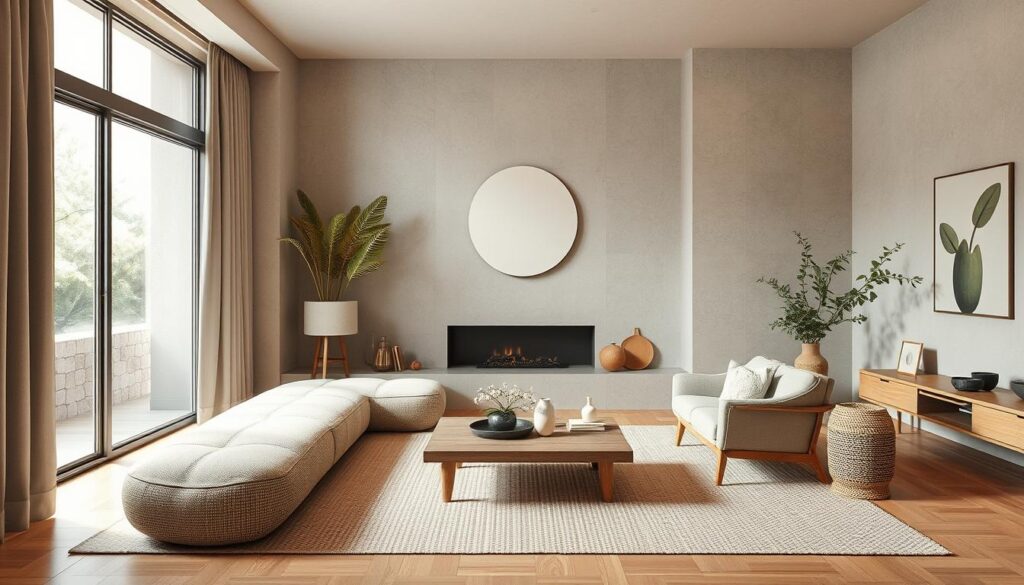
Japandi design mixes Japanese minimalism with Scandinavian elegance. It makes a living space that values simplicity. At its core is the wabi-sabi philosophy. This idea loves the natural flaws and the fleeting nature of things.
Wabi-Sabi: Celebrating Imperfect Beauty
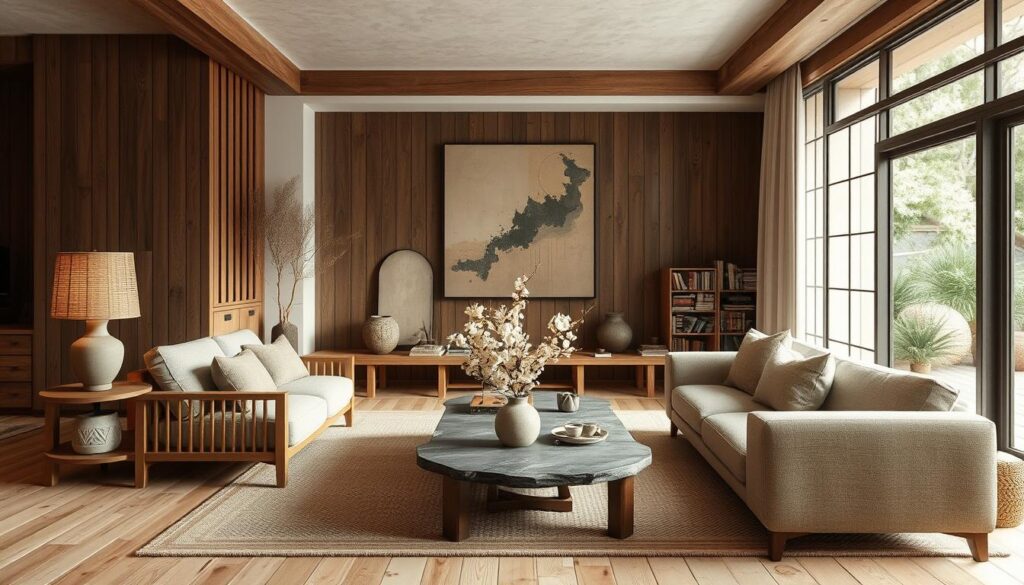
Wabi-sabi is key to Japandi. It teaches us to love natural textures and organic materials. Things like weathered wood and ceramic with slight imperfections add real charm. They make us slow down and enjoy the beauty around us.
Warm Minimalism: Cozy and Inviting Spaces
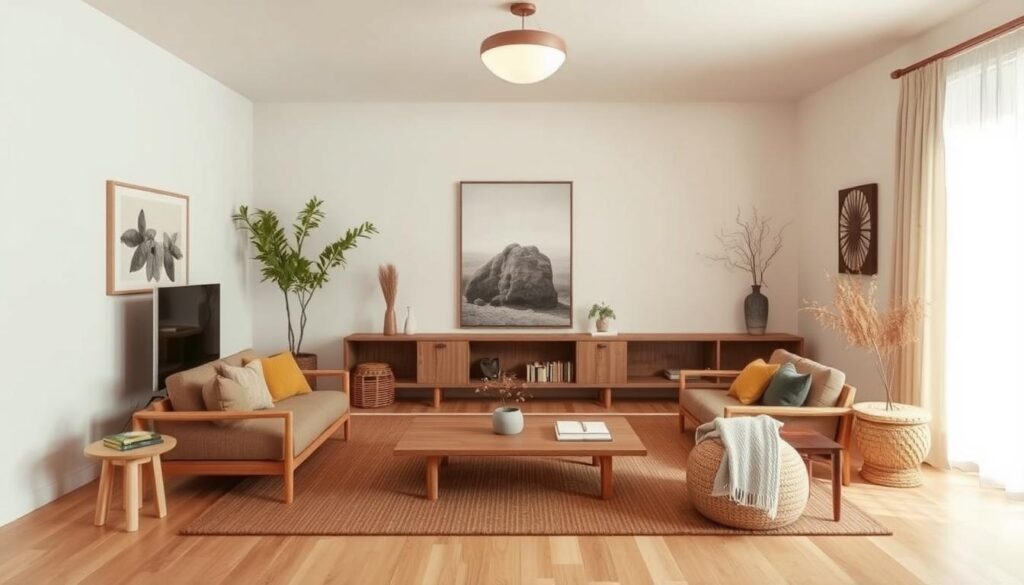
Japandi’s minimalist style is soft and warm, unlike some modern styles. It uses natural textures and organic materials. Japandi living rooms have a cozy feel, thanks to their muted colors and earthy tones. This makes them both beautiful and comfy.
| Design Element | Japandi Interpretation |
|---|---|
| Color Palette | Muted tones, earthy hues, and soft neutrals |
| Textures | Natural, organic materials like wood, stone, and bamboo |
| Furniture | Clean lines, minimalist silhouettes, and a focus on functionality |
| Decor | Minimal, carefully curated accessories that emphasize simplicity |
“Japandi design is a harmonious blend of Japanese minimalism and Scandinavian elegance, creating a serene and cocooning living space.”
Crafting Harmony with Contrasts
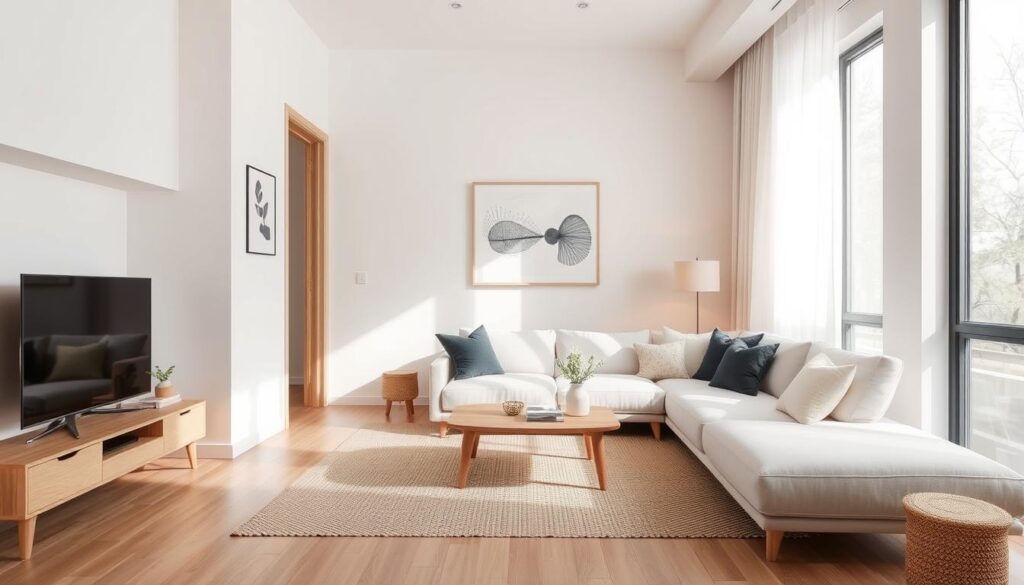
Japandi design is all about finding balance. It mixes the simplicity of Japanese design with the coziness of Scandinavian style. This creates spaces that look great and feel welcoming.
Blending Light and Dark Elements
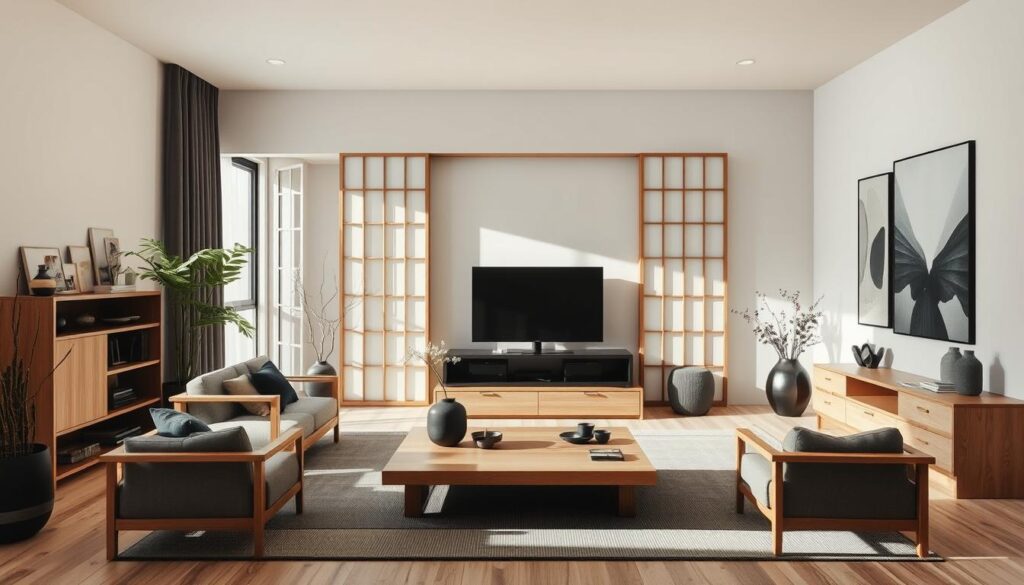
Japandi style is known for combining light and dark elements smoothly. Using light wood furniture with dark accents like charcoal or ebony adds depth. This mix of light and shadow makes the space balanced and harmonious.
Textural Richness: Nature’s Symphony
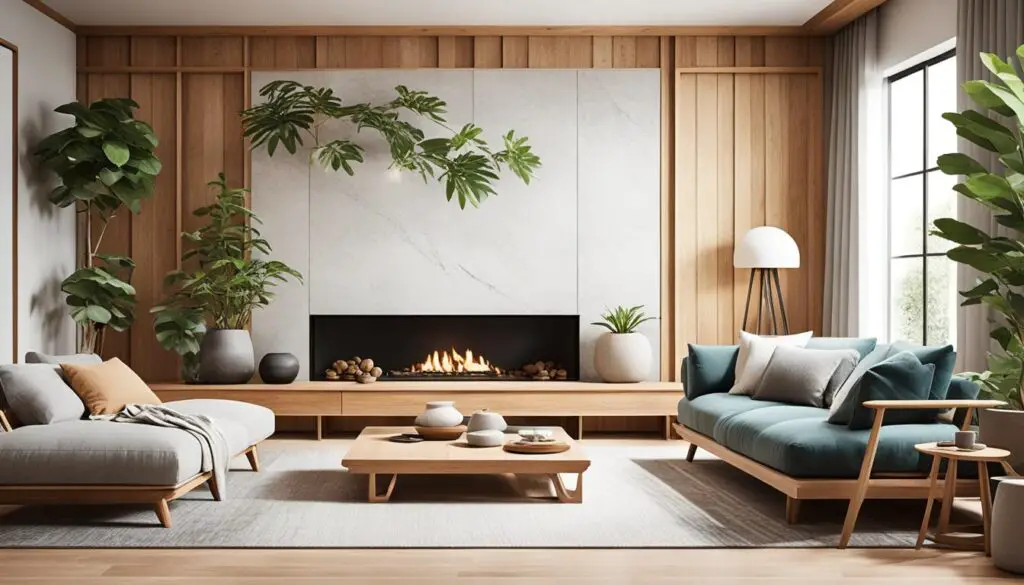
Japandi celebrates nature by using organic materials for texture. Wood, stone, and bamboo each add something special to the design. These materials make the space look better and feel more earthy.
| Material | Contribution to Japandi Design |
|---|---|
| Wood | Adds warmth, character, and a natural, grounded feel to the space. |
| Bamboo | Offers strength, sustainability, and a delicate, organic texture. |
| Stone | Brings a sense of rugged elegance and natural beauty to the design. |
| Ceramic | Introduces earthy tones and a tactile quality to the overall aesthetic. |
Japandi design uses light and dark and natural textures to create a beautiful, balanced space. It celebrates the beauty of balance.
Functional Simplicity: The Japandi Way
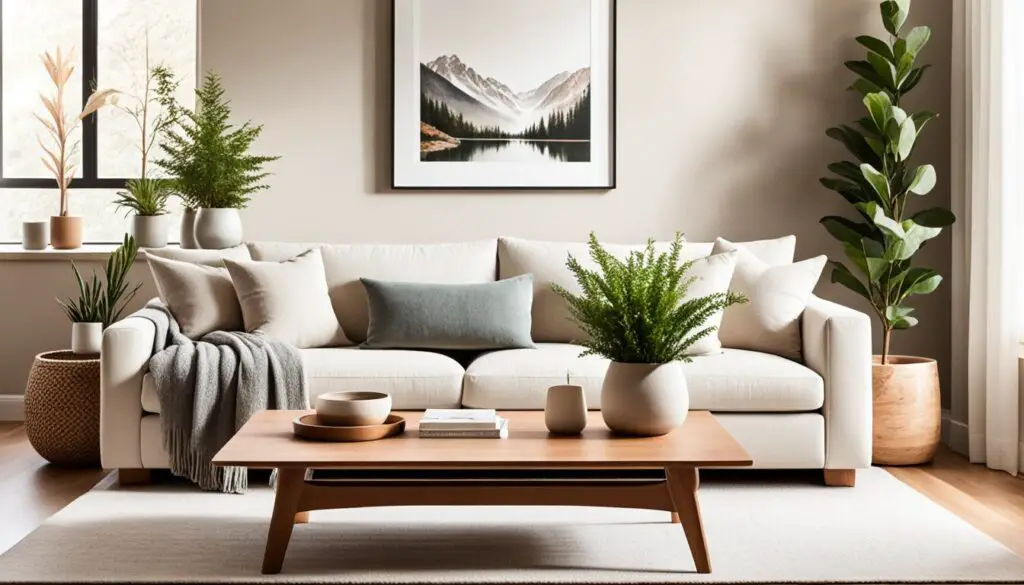
The Japandi style is known for its focus on simplicity. It combines Japanese and Scandinavian design to make spaces that look great and work well. This style uses clean lines and open layouts to make rooms feel both beautiful and practical.
The living room is a key part of Japandi design. Japandi design suggests using furniture that does more than one thing. It also recommends smart storage and a tidy layout to bring peace and quiet.
Japandi design is more than just pretty. It’s a choice that makes living easy and practical. Every detail, from furniture placement to natural light use, aims to make the room both beautiful and easy to live in.
“Japandi design is about finding the perfect balance between beauty and functionality, creating a living space that is as harmonious as it is useful.” – Interior Design Expert
By following Japandi, you can make your living room look good and work well for daily life. This design encourages a thoughtful, mindful way of living. It makes sure every part of the room adds to a calm, organized, and connected feel.
Natural Materials: Organic Elegance
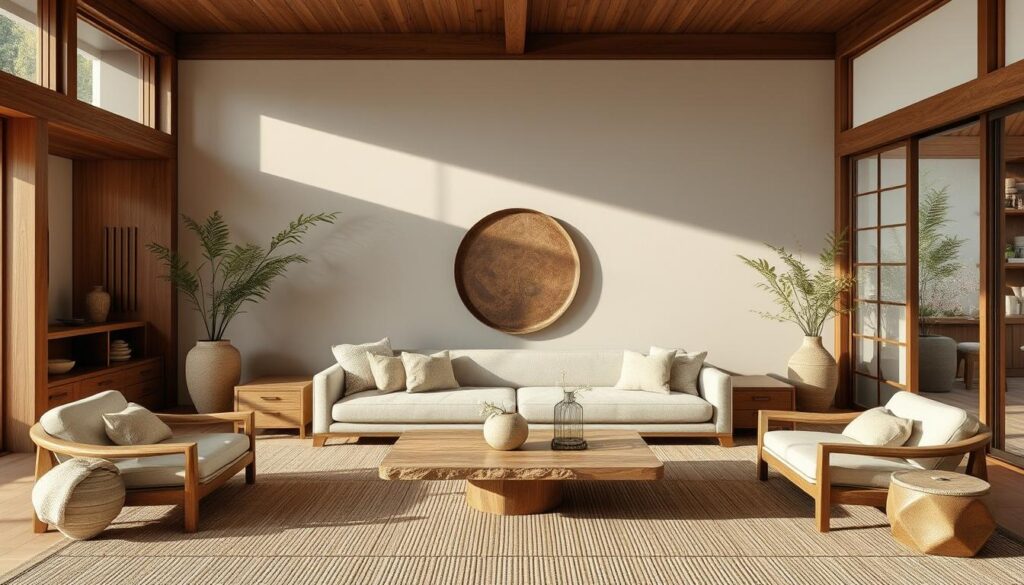
In the world of Japandi living rooms, natural materials shine. Wood, stone, and ceramic bring in a touch of nature. They make the space feel connected to the earth and add beauty with their unique looks.
Wood, Stone, and Ceramic: Earthy Accents
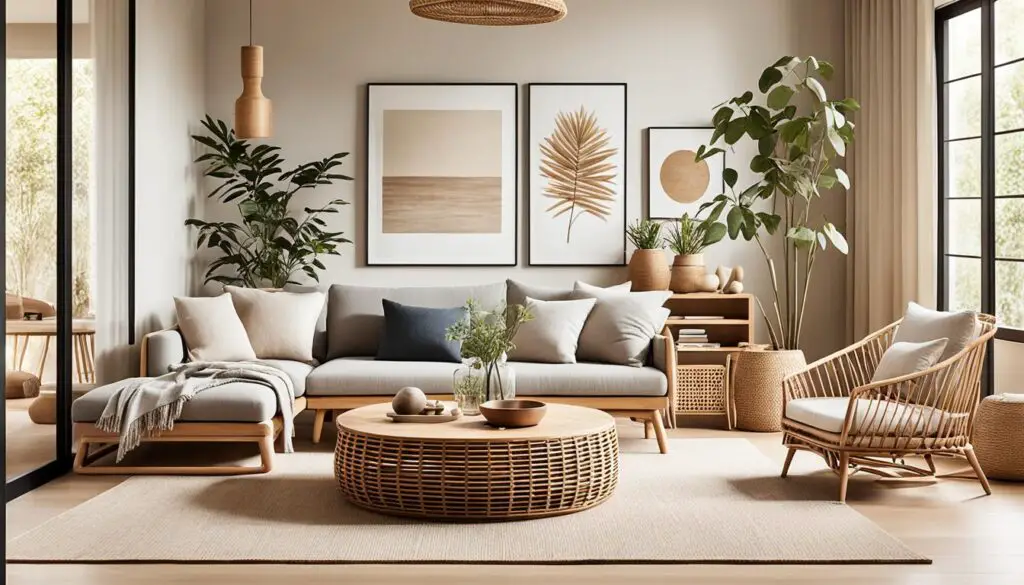
Japandi living rooms often use light-colored woods like oak or ash. These woods bring a calm and grounding feel. The unique grains and small imperfections of these woods show the real beauty of nature.
Adding stone, like marble or slate, and ceramic pieces brings a mix of natural materials together. This mix creates a look that feels timeless and full of organic elegance.
- Embrace the natural beauty of wood, stone, and ceramic in Japandi living rooms
- Light-colored woods like oak and ash create a warm, grounding atmosphere
- Embrace the unique textures and imperfections of natural materials
- Incorporate earthy accents to enhance the organic elegance of the space
“In Japandi design, the embrace of natural materials is a celebration of the imperfect beauty found in nature.”
Using natural materials in Japandi living rooms follows the design’s simple, sustainable, and nature-loving principles. These earthy accents make the space not just beautiful but also filled with organic elegance and timeless charm.
Clean Lines and Open Spaces
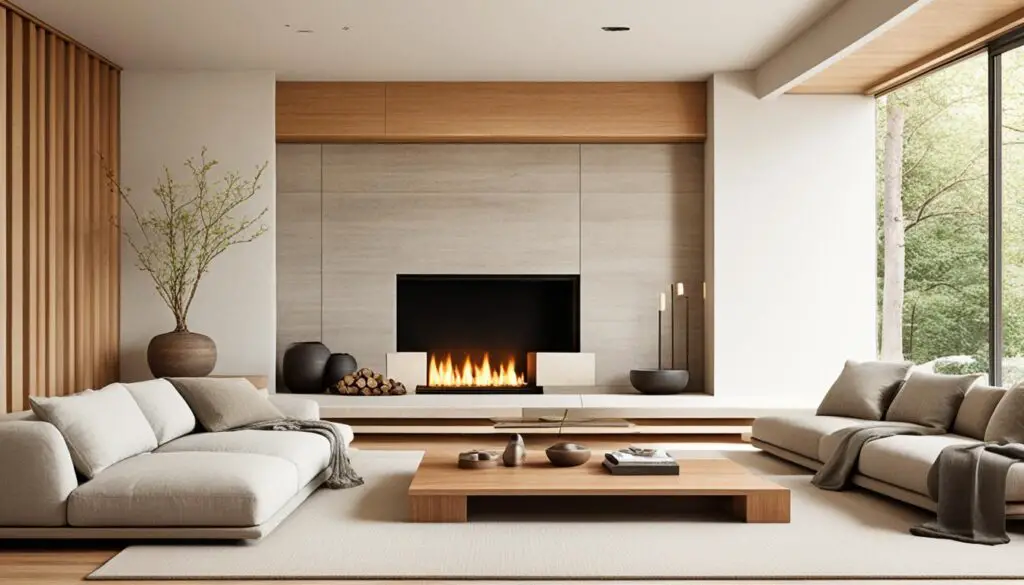
Japandi living rooms are known for their clean lines and open spaces. This creates a minimalist look that feels inviting and peaceful. The open floor plans and simple decor let the natural materials shine, making the space feel airy and balanced.
In a Japandi-inspired living room, furniture and decor have clean, simple lines. Low-profile sofas, coffee tables, and accent chairs show off a sleek, minimalist style. This style matches the room’s layout perfectly. Big windows and open doorways also help, making the space feel connected to the outdoors.
Open spaces are key in Japandi design. They help turn the living room into a peaceful spot that’s great for relaxing and being mindful. With fewer walls and barriers, natural light can enter freely, making the room feel even more open and clean.
The clean lines and open spaces in a Japandi living room make it a peaceful place. It’s all about enjoying the beauty of natural materials and simple design. This style helps people slow down, appreciate simplicity, and find peace in their surroundings.
Minimal Ornamentation: Embracing Authenticity
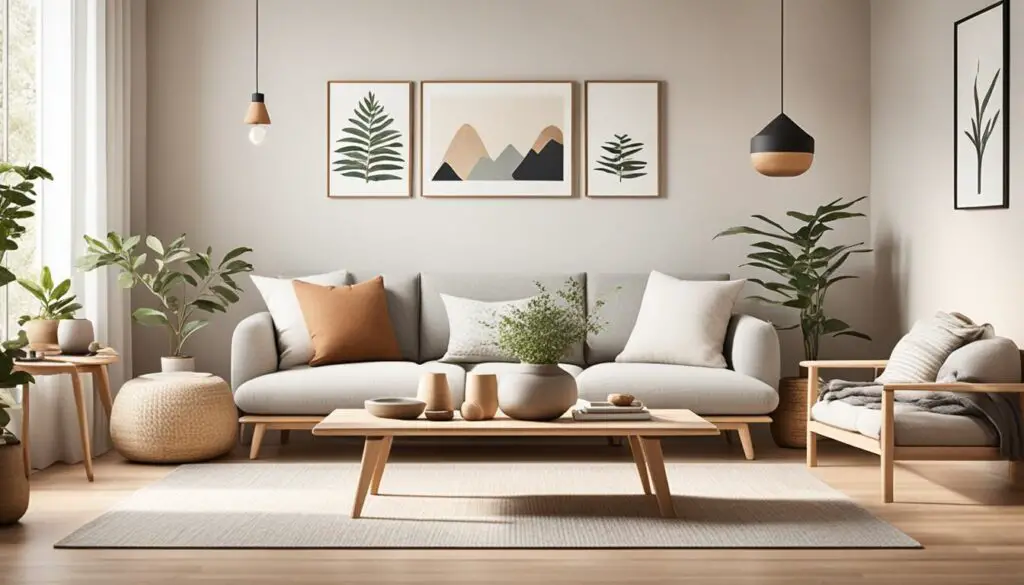
Japandi design is all about simplicity and being true to oneself. It uses a less-is-more approach. Every item in the space has a purpose, making the room peaceful and decluttered. This encourages mindful living.
Japandi style values authentic design and simplicity. It doesn’t need lots of decorations or flashy things. Instead, it focuses on the natural beauty of materials and the use of each piece. This minimal ornamentation lets the design’s true beauty stand out, bringing tranquility and balance.
Japandi-inspired spaces are calm and focused because they’re decluttered. Without too many decorations, they help people stay present and mindful. This design supports a mindful living lifestyle, making the space a simple and authentic oasis.
| Key Japandi Design Principles | Description |
|---|---|
| Minimal Ornamentation | Japandi style emphasizes simplicity and functionality, focusing on the inherent beauty of materials and the purpose of each design element. |
| Authentic Design | Japandi interiors embrace natural, high-quality materials and craftsmanship, promoting a sense of authenticity and timelessness. |
| Decluttered Spaces | Japandi design encourages a minimalist approach, creating calm and focused environments that foster mindful living. |
By following Japandi’s ideas of minimal ornamentation, authentic design, and simplicity, people can make their homes serene and decluttered. This mix of Japanese and Scandinavian styles brings a refined and timeless look to interior design.
Low-Profile Furniture: Grounding Your Space
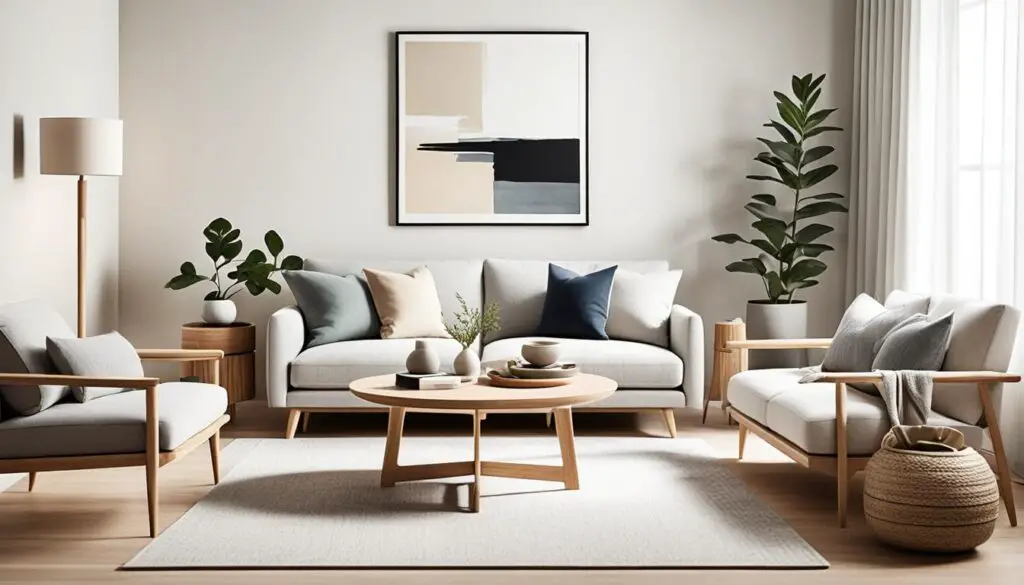
In Japandi living room design, low-profile furniture is key. It helps create a cozy, intimate feel. This style comes from Japanese floor seating and Scandinavian clean lines.
Sofas and armchairs with a low profile bring balance and harmony to the room. They’re often covered in neutral fabrics or natural materials. This makes the space feel cozy and welcoming.
Low-profile furniture is matched with coffee and side tables that also feel grounded. Made from wood, stone, or ceramic, these tables add to the peaceful vibe. They connect us to nature.
| Design Element | Japandi Inspiration | Benefits |
|---|---|---|
| Low-profile furniture | Japanese floor seating | Creates a grounded, intimate atmosphere |
| Natural materials | Scandinavian minimalism | Enhances visual balance and harmony |
| Clean lines and open spaces | Scandinavian design influences | Fosters a sense of calm and relaxation |
Japandi living rooms use low-profile furniture and natural materials for a balanced look. This mix of styles brings together the best of Japanese and Scandinavian design. The result is a peaceful, inviting space that encourages relaxation and mindfulness.
“The beauty of Japandi design lies in its ability to create a sense of grounded simplicity, where form and function seamlessly coexist.”
Bringing Nature Indoors with Greenery
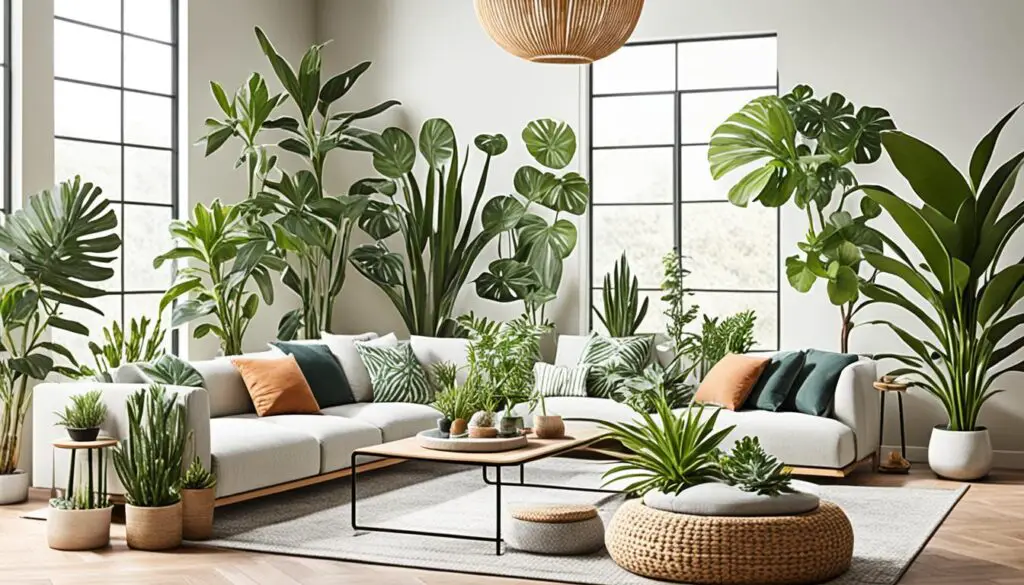
Japandi living rooms love to bring in greenery. They add color and life, connecting us to nature. This fits the Japandi way of living close to the natural world.
The Japandi style uses biophilic design to bring nature inside. Houseplants are key, adding greenery that links indoors with outdoors.
Placing plants in a Japandi living room changes the feel. It brings calm and harmony. A potted fiddle-leaf fig, trailing ivy, or succulents on the coffee table can do this.
| Benefits of Incorporating Greenery in Japandi Living Rooms | Examples of Suitable Indoor Plants for Japandi Style |
|---|---|
| Enhances the connection to nature Adds a soothing, serene atmosphere Purifies the air and improves indoor air quality Promotes a sense of well-being and relaxation Complements the minimalist, natural aesthetic of Japandi | Fiddle-leaf fig Snake plant Monstera deliciosa Pothos ZZ plant Succulents (e.g., echeveria, jade plant) |
Adding greenery to a Japandi living room makes it peaceful and refreshing. It mixes nature with the style’s clean, simple, and elegant look.
Japandi Living Room: A Neutral Haven
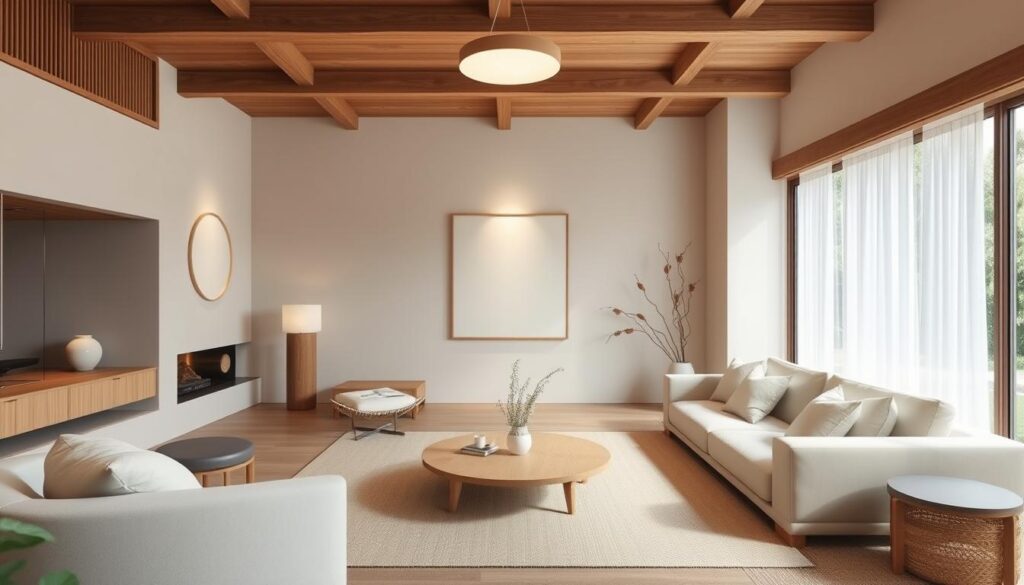
Japandi living rooms are known for their calm and peaceful feel. They use a neutral color palette inspired by nature. Colors like white, off-white, gray, beige, and brown make a soothing background. This lets natural materials and textures shine.
This color scheme fits well with the minimalist aesthetics of Japandi design. It makes the space look both calming and beautiful.
Muted Color Palettes: Inspired by Nature
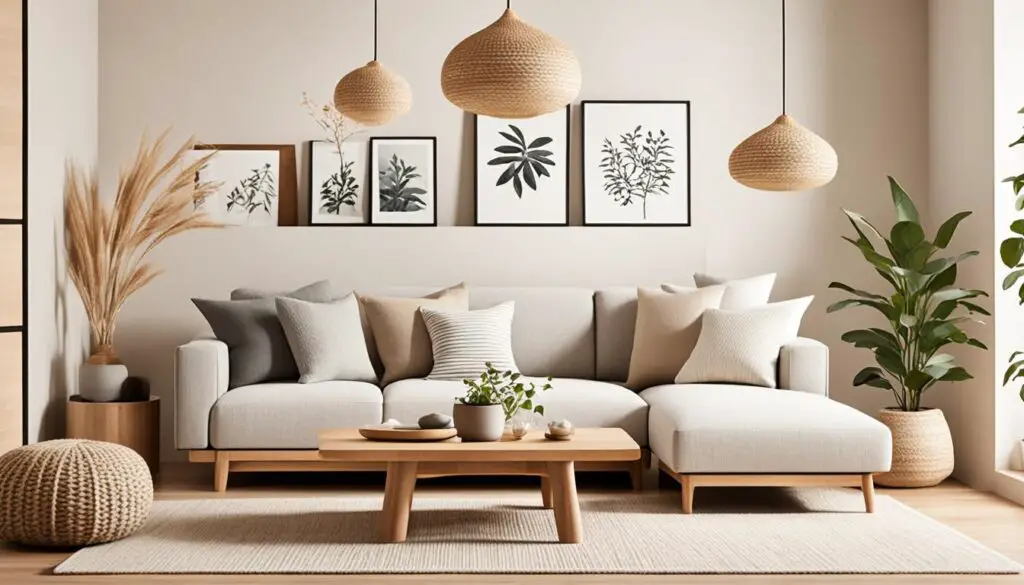
The Japandi style loves the beauty of nature-inspired colors. It uses muted tones to create a peaceful feel. This neutral color palette mixes Japanese elegance with Scandinavian minimalism.
Soft colors like warm beige, light gray, and subtle blue-gray set the mood. Adding nature-inspired accents like emerald green, terracotta, or muted mustard brings depth. These colors add interest without losing the minimalist aesthetics.
“The beauty of Japandi design lies in its ability to create a harmonious, nature-inspired environment that soothes the senses and invites relaxation.”
Maximizing Natural Light: A Zen Ambiance
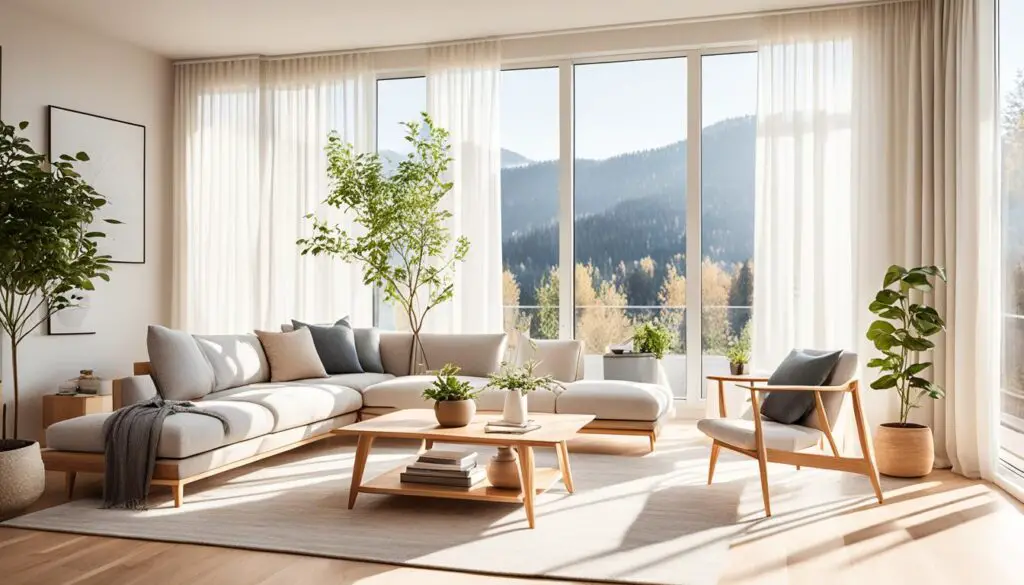
Japandi living rooms are all about using natural light to create a peaceful and open feel. They mix Nordic elegance with Japanese zen to make living areas that are both beautiful and calm.
Big windows and sliding glass doors are key in Japandi-style living rooms. They let in lots of natural light. This light makes the room bright and highlights the beauty of materials like wood, stone, and natural fibers.
Open floor plans in Japandi design make the space feel bigger. The natural light can move through the whole room, making it feel fresh and airy. This connection to nature is key to the Japandi way of life, bringing peace and calm.
Using minimalist decor helps make the most of natural light. Simple furniture and plants placed thoughtfully let the light move freely. This creates a peaceful, meditative space that is truly Japandi.
Finding Balance in Design
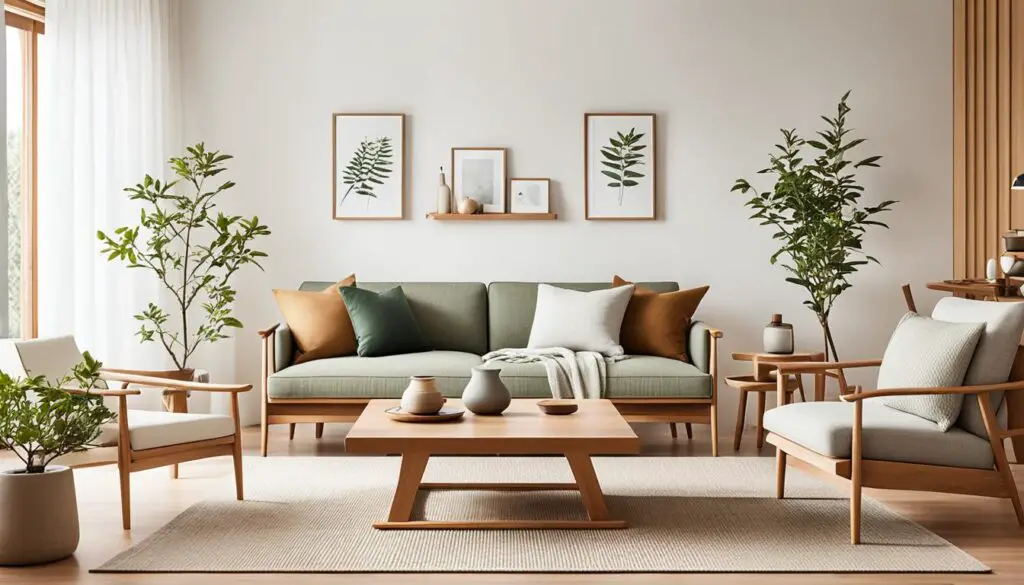
Japandi design is all about finding the perfect balance. It combines Japanese and Scandinavian styles beautifully. This balance is key to making a peaceful and beautiful living space. It’s about mixing light and dark elements, understated and statement pieces, and simple and complex designs.
At the core of Japandi design is the idea of balance in design. It’s about picking materials, textures, and tones carefully. This creates a calm and unified living room. Natural materials like wood, stone, and bamboo are used, along with minimalist furniture. This makes the space simple yet sophisticated.
The Japandi style loves the beauty of contrasts. Light and dark colors work together perfectly. Big windows let in lots of natural light, while darker colors like charcoal grey or black add depth. This mix of light and dark makes the room peaceful and balanced.
Getting the right balance in a Japandi space means mixing understated and statement pieces. Simple furniture is the base, with statement pieces like art or unique lighting adding interest. This balance keeps the space uncluttered and inviting.
In Japandi design, simplicity and complexity go hand in hand. The look may seem simple and streamlined, but there are many textures and details. From the natural grain of the wood to the tactile quality of the fabrics, each part adds to the space’s beauty.
By finding the perfect balance, a Japandi-inspired living room becomes a peaceful and elegant place. It shows how Eastern and Western design can come together beautifully.
Hidden Storage: Clutter-Free Tranquility
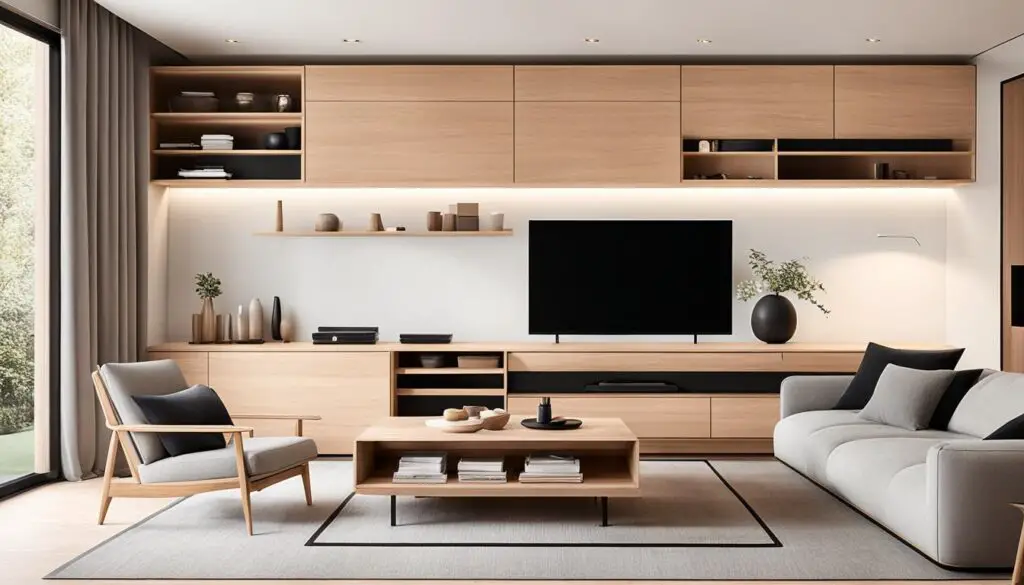
Japandi design focuses on a peaceful, simple living space. It uses smart storage to keep things tidy. This way, Japandi living rooms look calm and balanced, matching the idea of simple living.
Japandi style is known for its smart hidden storage. Japandi sideboards help use small spaces well, with many compartments and shelves. They keep things like dishes, books, and decorations in order, all while looking neat.
Japandi loves mixing nature with hidden spots. It uses soft colors like white, gray, green, and brown for a calm feel. Earthy greens, indigo, and yellow add some pop. Using wood and bamboo shows Japandi’s goal of bringing the outdoors in.
| Japandi Storage Features | Benefits |
|---|---|
| Multiple compartments and shelves | Efficient and organized storage |
| Adjustable shelves and drawer organizers | Customizable and versatile storage solutions |
| Neutral color palettes | Calming and serene atmosphere |
| Natural materials like wood and bamboo | Blend of nature and minimalist design |
With hidden storage, Japandi living rooms stay tidy and peaceful. This design lets people live simply and in tune with their space. Japandi celebrates the beauty of useful design, making minimalist living possible.
Celebrating Craftsmanship and Artistry
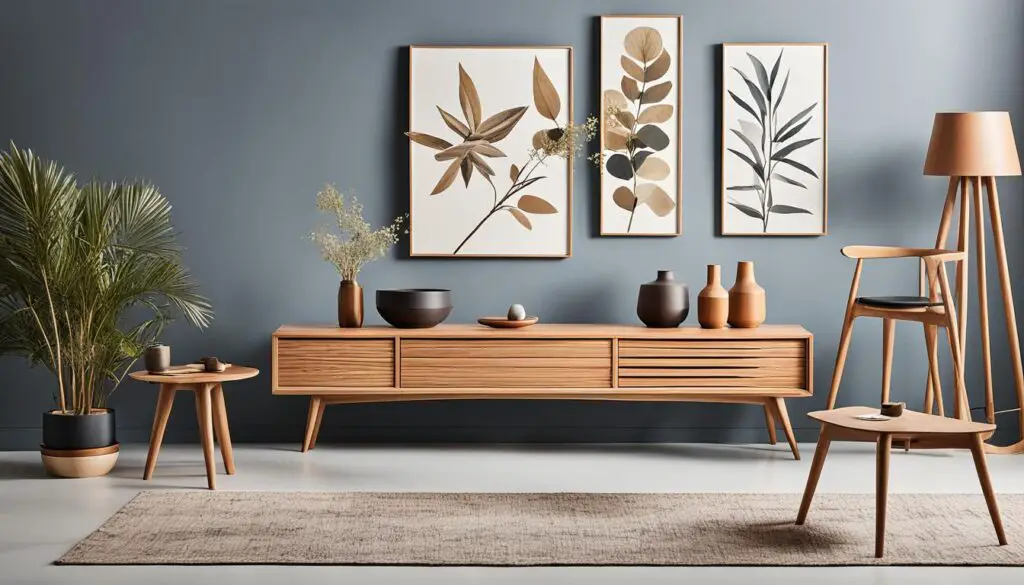
Japandi design honors the beauty of high-quality craftsmanship and making unique, personalized spaces. It values the art of creating artisan pieces that share a story. These pieces add authenticity and uniqueness to any living room.
Japandi design loves the unique look and natural flaws of handcrafted items. For example, the different grain patterns on a wooden table or the unique shapes of a ceramic vase. Each item shows the skill of the person who made it.
By choosing high-quality craftsmanship, Japandi fans make personalized spaces that show their style and tastes. Items like a hand-woven rug, a custom sofa, or a unique sculpture become key parts of the room. They add warmth and character.
| Japandi Design Principle | Key Characteristics |
|---|---|
| Craftsmanship and Artistry | Appreciation for high-quality, handcrafted pieces Embrace of natural imperfections and unique designs Creation of personalized spaces through artisan pieces Celebration of the skilled human touch in furniture and decor |
Japandi design lifts the living room to a higher level. It turns it into a peaceful place that shows the owner’s unique style and love for unique design.
“Japandi design celebrates the inherent beauty of imperfection, embracing the unique character and story behind each handcrafted piece.”
Quiet Corners: Embracing Zen Living
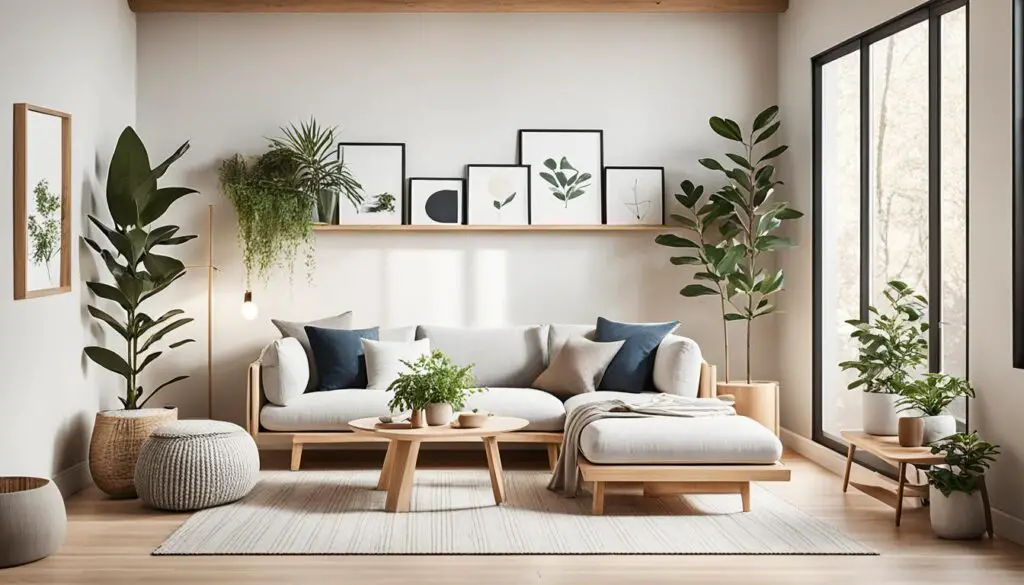
In the heart of a Japandi-inspired living room, a tranquil corner awaits. It’s a sanctuary for unwinding and reconnecting with the present. Here, quiet corners offer a space to escape daily life’s hustle.
The core of Zen living shines in these serene spots. Mindful design and relaxation lead the way. With minimalist furniture, like a cozy armchair or plush cushion, you can relax and think deeply.
The Japandi living room surrounds these quiet spots with a calming color scheme. Earthy tones and natural textures bring peace. Smooth wood, woven accents, and soft fabrics create a zen-inspired feel, making the space welcoming.
“In the midst of movement and chaos, find stillness. In the midst of chaos, find peace.”
– Deepak Chopra
Quiet corners remind us to slow down and breathe. By adding these spaces to a Japandi living room, we can deepen our mindfulness. This lets us fully embrace Zen living at home.
Adding quiet corners to Japandi living rooms shows the style’s focus on balance and peace. These spaces are perfect for recharging and reflecting. They capture Japandi’s mix of Japanese and Scandinavian design.
Japandi Living Room: Less is More
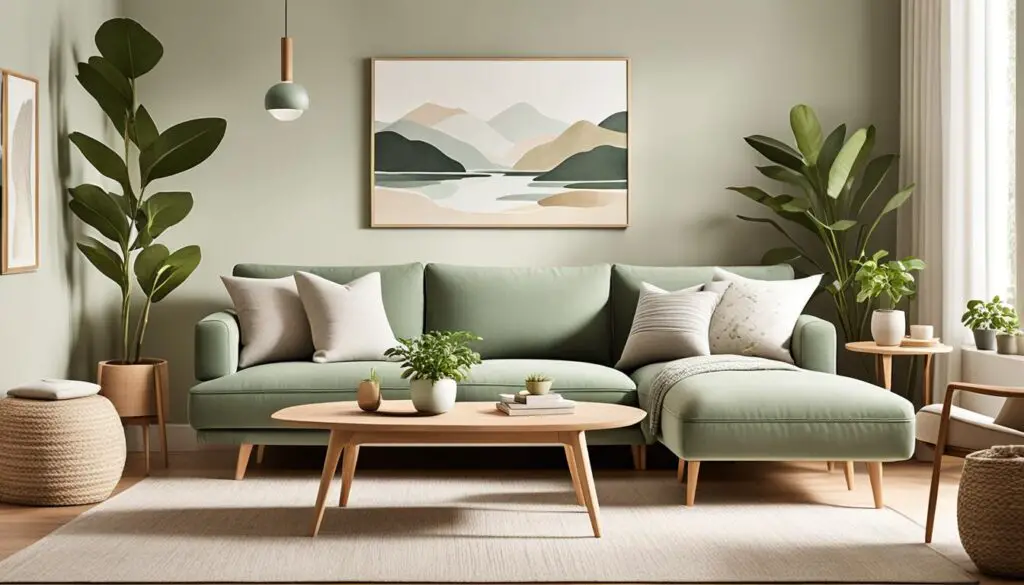
The Japandi living room focuses on minimalism and simplicity. It uses “less is more” to create a calm and balanced look. This design celebrates natural materials and details. It makes spaces feel serene and lets each piece stand out.
At the core of the Japandi living room is minimalist design. Furniture is chosen for its clean lines and many uses. This keeps the room tidy and looking good. Colors like beige, gray, and natural wood add to the peaceful feel.
Natural light is key in a Japandi living room. Big windows or sliding doors let in lots of daylight. This creates a zen-like ambiance and connects indoors with outdoors. Lighting like rice paper lamps or black metal accents adds to the calm feel.
Japandi living rooms aim to be both functional and balanced. They use minimalism, decluttered spaces, and natural materials. This brings together Japanese and Scandinavian design for a peaceful and beautiful space.
“The true essence of Japandi living room design is found in the careful balance of form and function, where every element contributes to a sense of calm and tranquility.”
More Japandi Living Room ideas
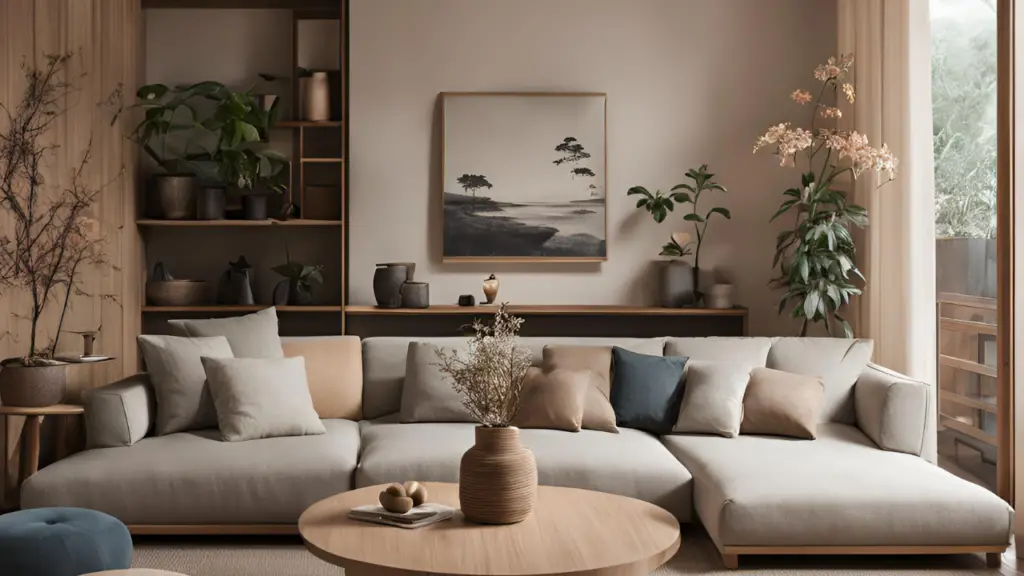
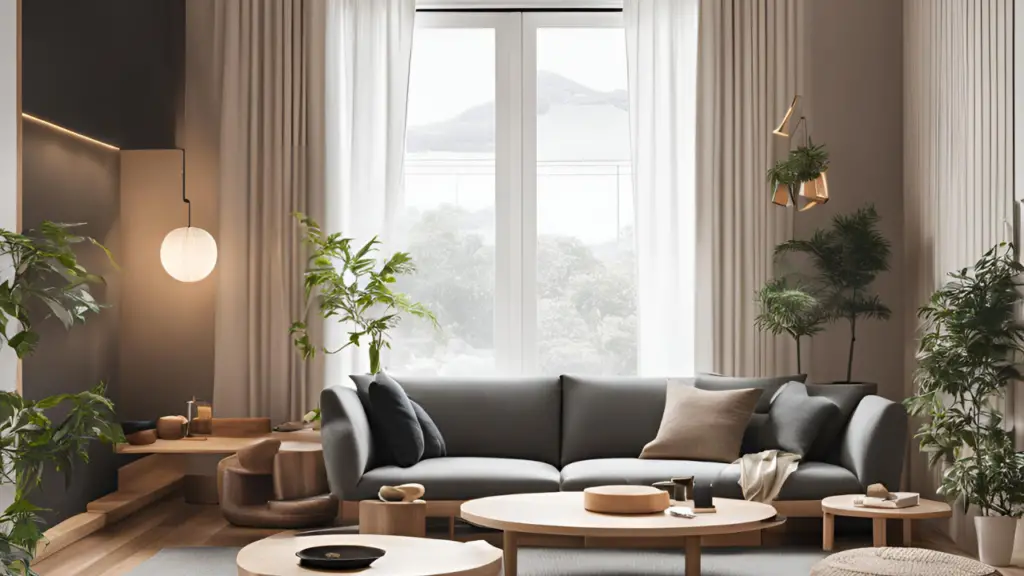
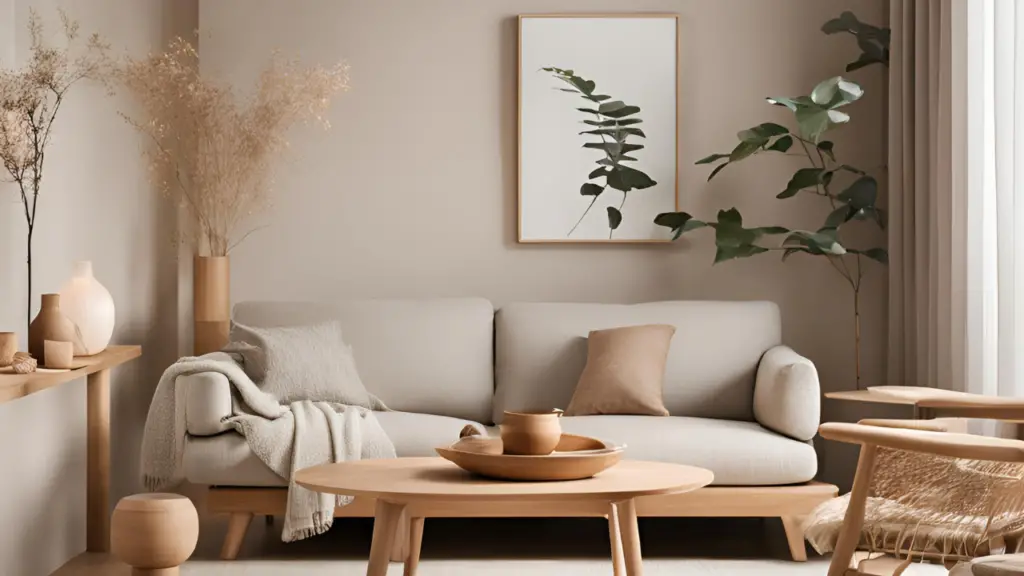
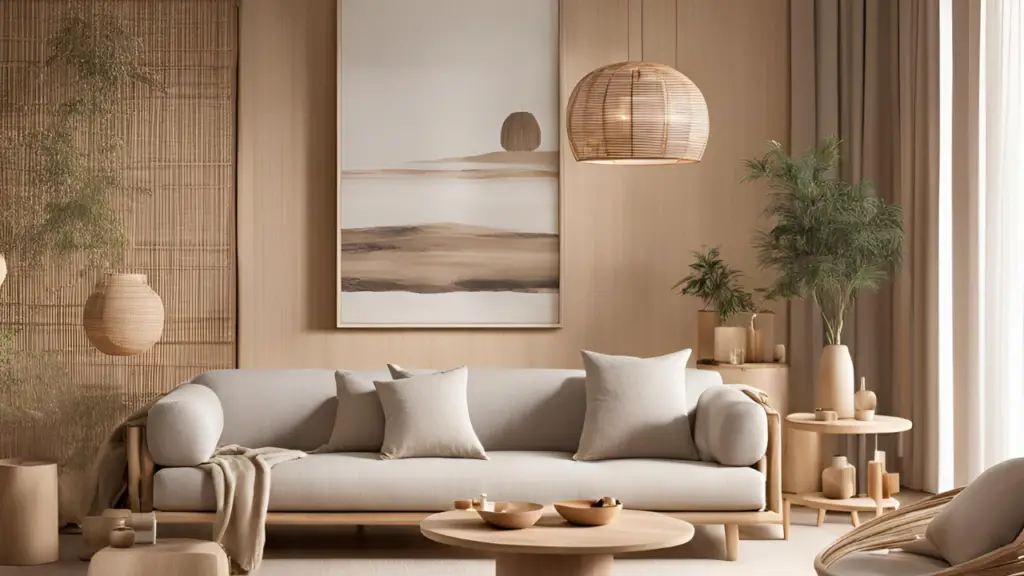
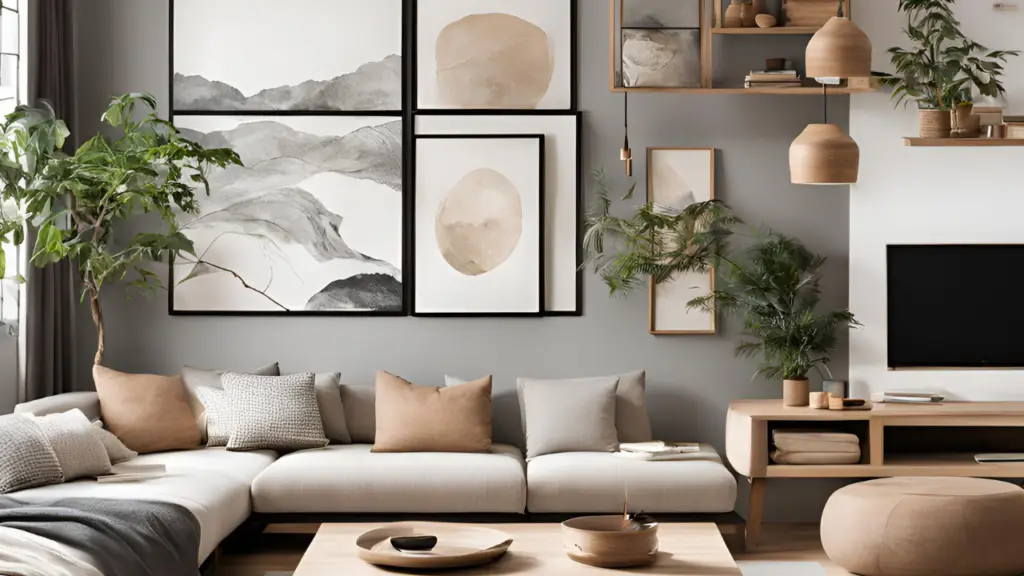
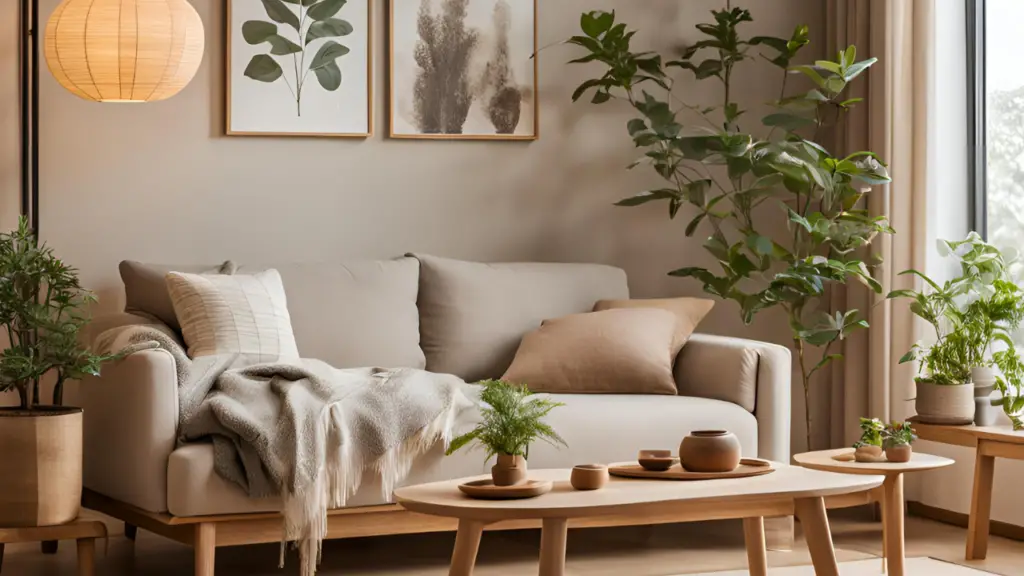
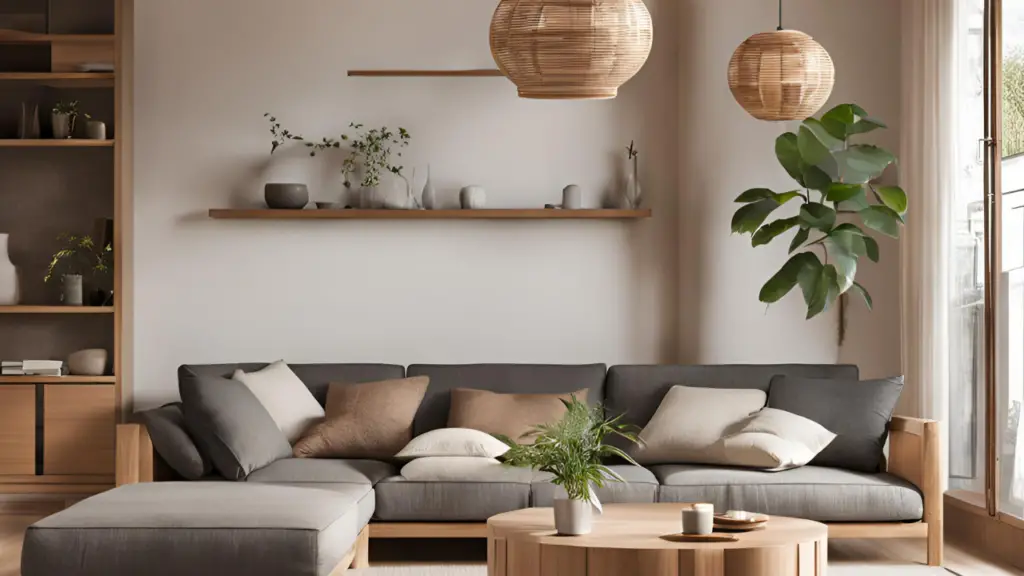
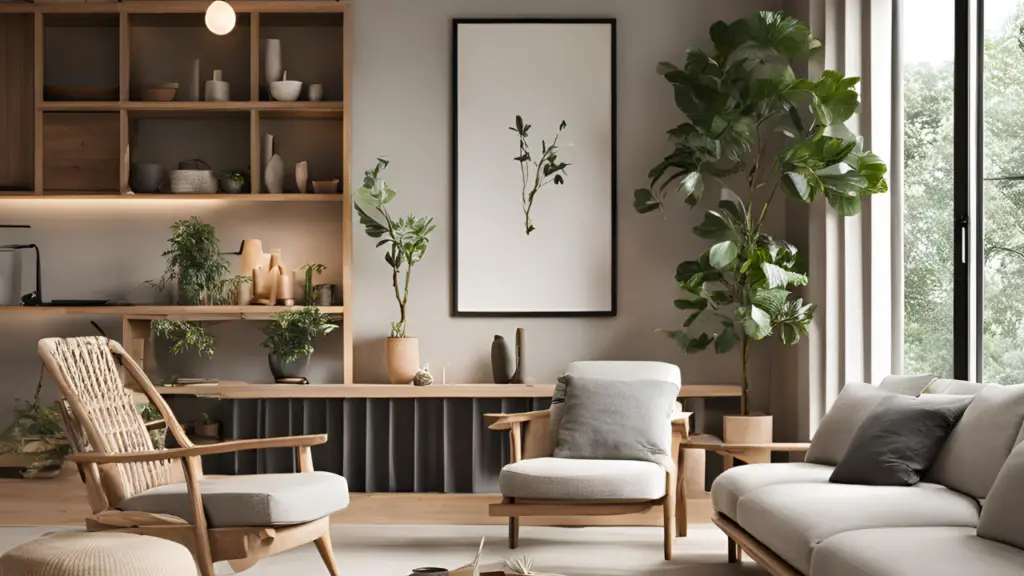
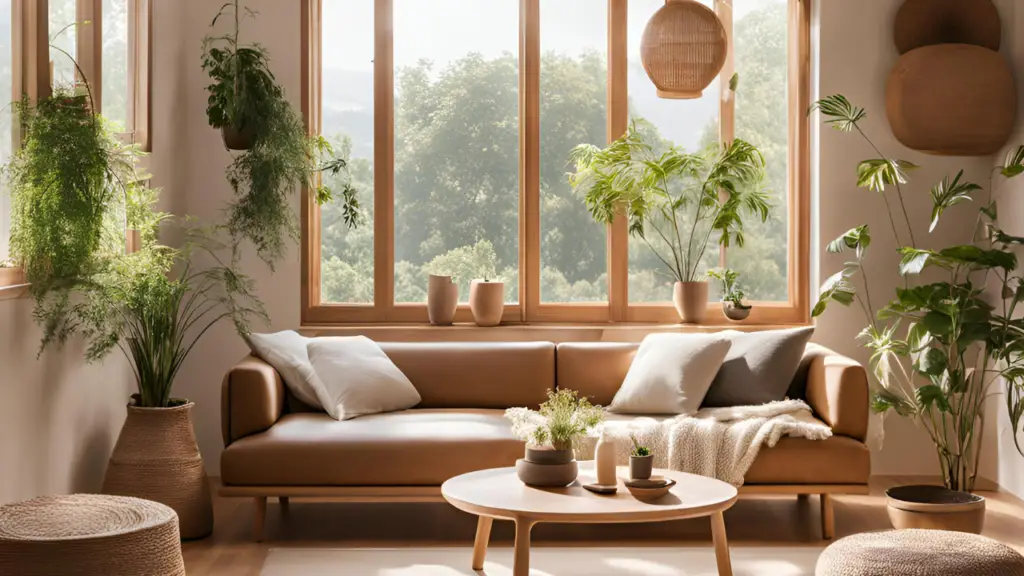
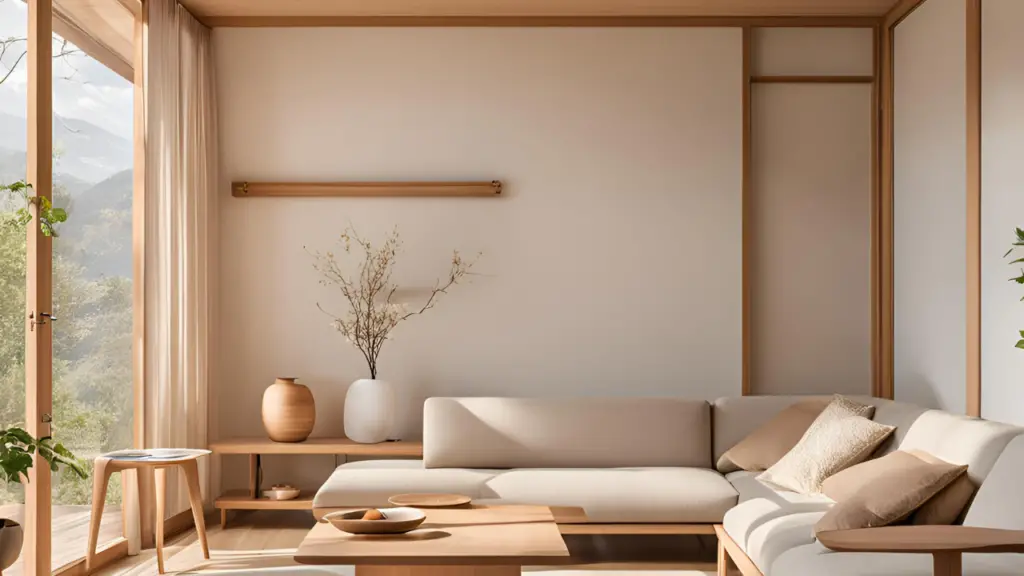
Conclusion: Harmonizing East and West
Japandi style combines Japanese minimalism and Scandinavian functionality. It creates spaces that are both relaxing and comfortable. This blend brings together the best of Eastern and Western design.
This mix of cultures makes spaces that are peaceful and welcoming. Japandi living rooms use the Japanese Zen philosophy and Scandinavian Hygge. They focus on simplicity, natural elements, minimalism, harmony, and functionality.
Whether you like Japandi’s clean lines or the warm, organic feel, this design is perfect. It meets your practical needs and helps you create a peaceful, harmonious space.
FAQ
What is Japandi style?
Japandi style mixes Japanese minimalism with Scandinavian functionality. It makes living spaces calm and serene. Clean lines, natural materials, and a link to nature are key.
What are the key design principles of Japandi?
Japandi focuses on the wabi-sabi philosophy and warm minimalism. It combines light and dark, and uses natural materials like wood, stone, and ceramic.
How does Japandi embrace the wabi-sabi aesthetic?
Japandi loves the beauty in imperfections. It uses natural, slightly imperfect materials. This adds charm and character to spaces, following the wabi-sabi philosophy.
What is warm minimalism in Japandi design?
Warm minimalism in Japandi means softness and coziness over starkness. It uses muted tones, organic shapes, and inviting textures. This creates a calm and welcoming space.
How does Japandi design balance light and dark elements?
Japandi balances light and dark by mixing them. It pairs light wood furniture with darker accents. This creates harmony through contrasts.
What is the importance of textural richness in Japandi living rooms?
Textural richness is key in Japandi design. It uses natural materials like wood, bamboo, stone, and ceramic. This creates a mix of organic textures and visual interest.
How does Japandi design focus on functional simplicity?
Japandi focuses on simple functionality. It uses minimal decor, clean lines, and open floor plans. This creates a calm and tranquil space.
What are the common natural materials used in Japandi living rooms?
Japandi living rooms use natural materials like wood, stone, and ceramic. These materials add organic elegance and connect us to nature.
How do Japandi living rooms incorporate greenery?
Japandi living rooms often have indoor plants. These plants add color and life, connecting us to nature. They follow the Japandi philosophy of embracing nature.
What are the typical color palettes used in Japandi living rooms?
Japandi living rooms have a neutral color palette. They draw from nature, using white, off-white, gray, beige, and brown. This creates a calm and serene atmosphere.

